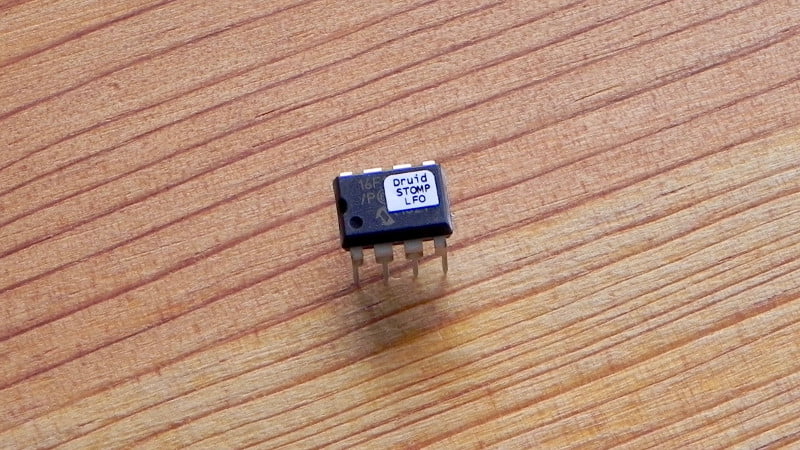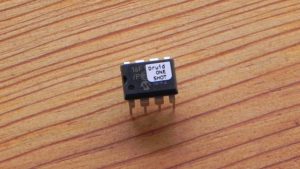Description
The STOMPLFO tap tempo LFO chip is a simplified 8-pin version of our popular TAPLFO chip. It is intended to replace the typical (and boring!) dual op-amp Schmitt trigger/integrator LFO that turns up in a million stompbox and guitar pedal designs. Available in DIP8 or SOIC8 packages.
It provides 8 waveforms including two interesting random waves, and can generate frequencies from 0.05Hz to 25Hz.
The LFO frequency, waveform selection, LFO depth, and output offset voltage are all voltage-controlled using 0-5V.
Download Electric Druid STOMPLFO tap tempo LFO Datasheet
The datasheet includes example circuit diagrams, example waveforms, and the chip pinout diagram.
If you’d like to program your own chip for personal use, code and further details are available over on the original article about the new Druid chips.







Rich pyper (verified owner) –
What a fantastic chip. No more non polarised caps in integrator/schmitt trigger lfo’s.
Everything I ever wanted in an lfo in a simple 8 pin dip package.
R.Pyper.
Gary Kalar –
Hard to imagine a reason NOT to use these LFOs, they’re the perfect solution to LFO in a tight fit, syncable, and with probably more functions than you’re going to need, rarely see hardware with this many options for the LFO. To do this discreetly would take a hell of a lot of real estate!
Tom Wiltshire –
Thanks Gary. Glad you’re enjoying the chips!
Nick –
Bought a couple of these last year and finally got around to making some boards. Beyond delivering a ton of waveforms in a tiny chip, the unit is incredibly user-friendly and the documentation is great. Couldn’t be happier.
Ben (verified owner) –
I followed the example circuit in the data sheet to build this as a second LFO for my Moog Werkstatt. I’m taking the 5V power from the Werkstatt, and only need 0-5V as an output, all of which makes this a very simple circuit to build. You can get some great didg-type sounds by setting the LFO to random slopes and plugging it in to the VCF CV in. It was great to build this first to get my confidence up before I moved on to the more complex ENVGEN 8C modular circuit.
I purchased two of these chips and am thinking about how I might add CV inputs to the circuit that I’ve already built. I would love to add CV jacks for rate, depth and offset to be able to modulate those parameters with CV. Tom, would it be possible to do this by copying the Level and Time CV sections (including the power regulation stuff) from the modular synth envelope schematic (ENVGEN 8C)?
Matthew Sanford (verified owner) –
Tom, I love this chip! I was wondering if you’ve considered creating and selling PCBs for the datasheet circuits with active/passive out, tap, led/vactrol. 2N3904 (ok that’s not on the datasheet…but useful!)? I’ve started playing with an old friend of the synth vein, so am working a box for it, did clusters of TRS jacks w/10k pots (tip to middle, ring to right, ground to left) so it can disconnect the pot when plugged in, and now CV can mess with the depth, rate, waveform, offset…still, PCB for it (and the One-Shot too!) would be amazing!
Ed (verified owner) –
Can you tell me if the stomp lfo can work in +5V/-5V output as the taplfo3, if I make the circuit for modular in the manual of the taplfo3 ?
Because I would like to make a lfo in +5V/ -5V but I do not need all the functions of the taplfo3 and I already have stomp lfo
Best regards
Tom Wiltshire –
Yes, you can use the TAPLFO3 filter schematic with the StompLFO and you’ll get a +/-5V output. It should be fine.
Matt Valentine (verified owner) –
Awesome and super simple to use!
Highly recommend. Thanks dude!
Joe –
Looks amazing! Is there any way to do a retrigger/sync function; ie when a new note is pressed, the lfo cycle restarts? Thanks!
Tom Wiltshire –
A single tap on the Tap Tempo input will do this, but the limitation is that another tap within two seconds will reset the frequency. If you want an LFO with a hard sync, the VCLFO offers this feature:
https://electricdruid.net/product/vclfo-10/
Matt Valentine (verified owner) –
Excellent little chip! Tom is a legend. Best customer service ever!
100/10!